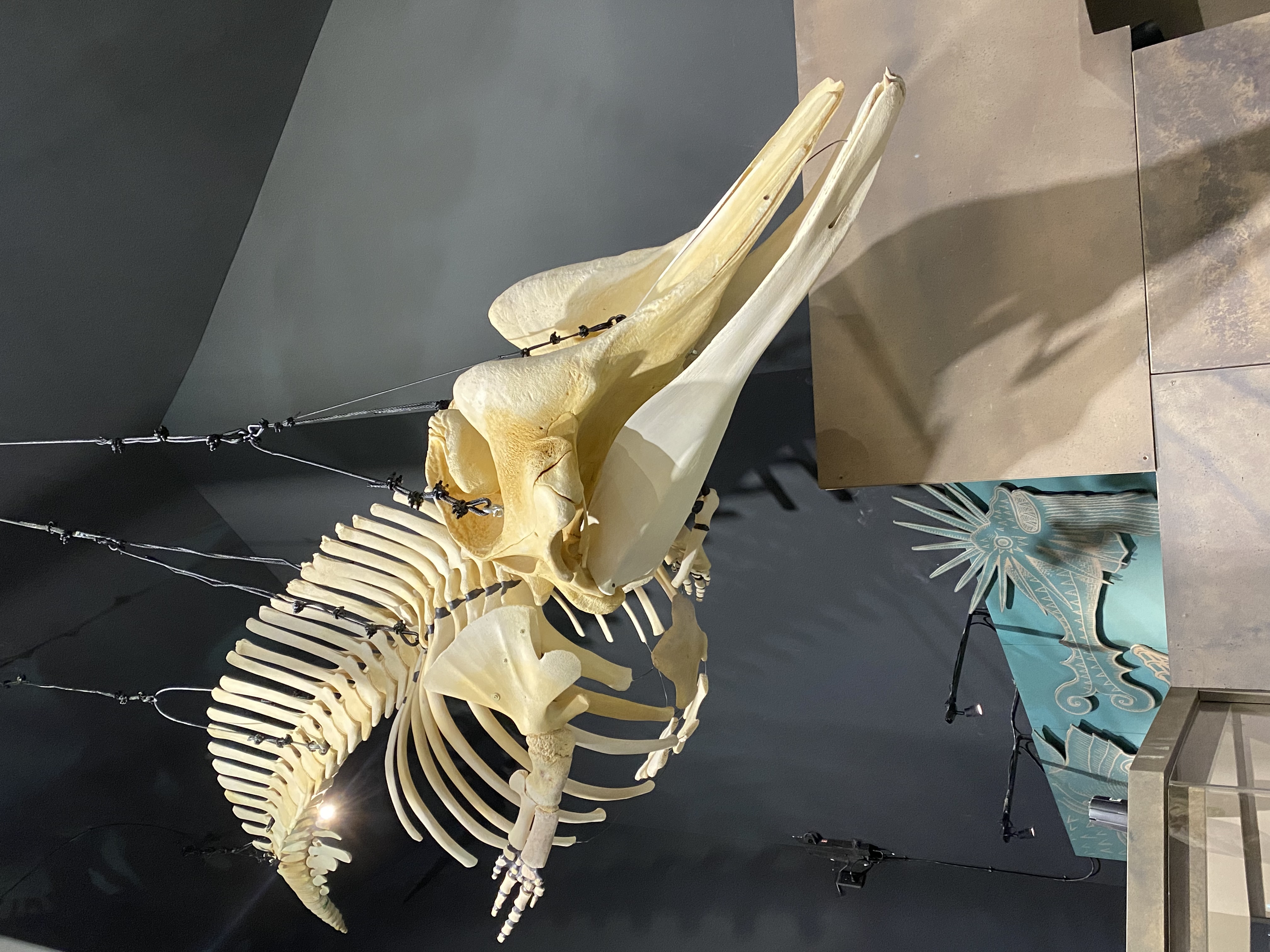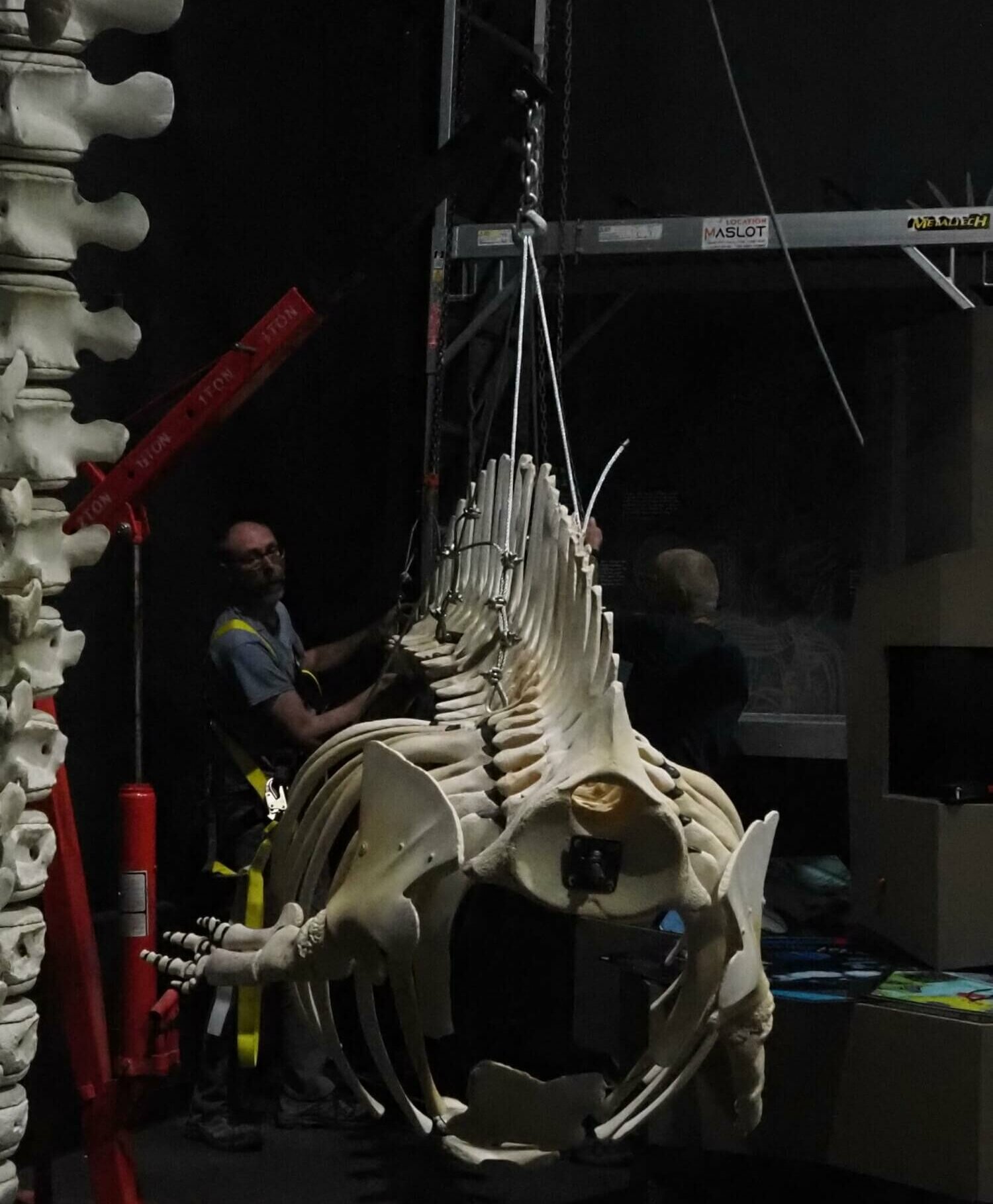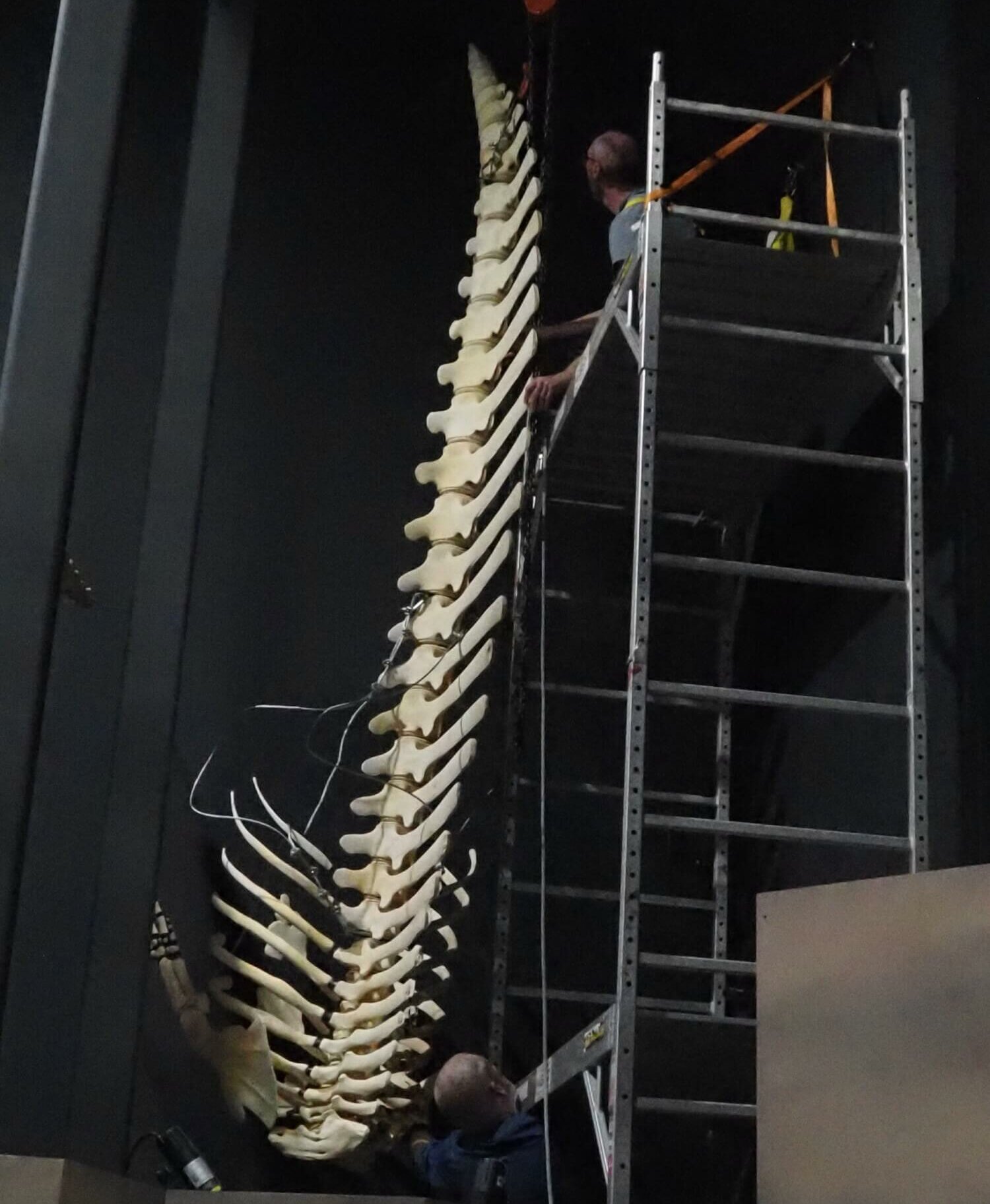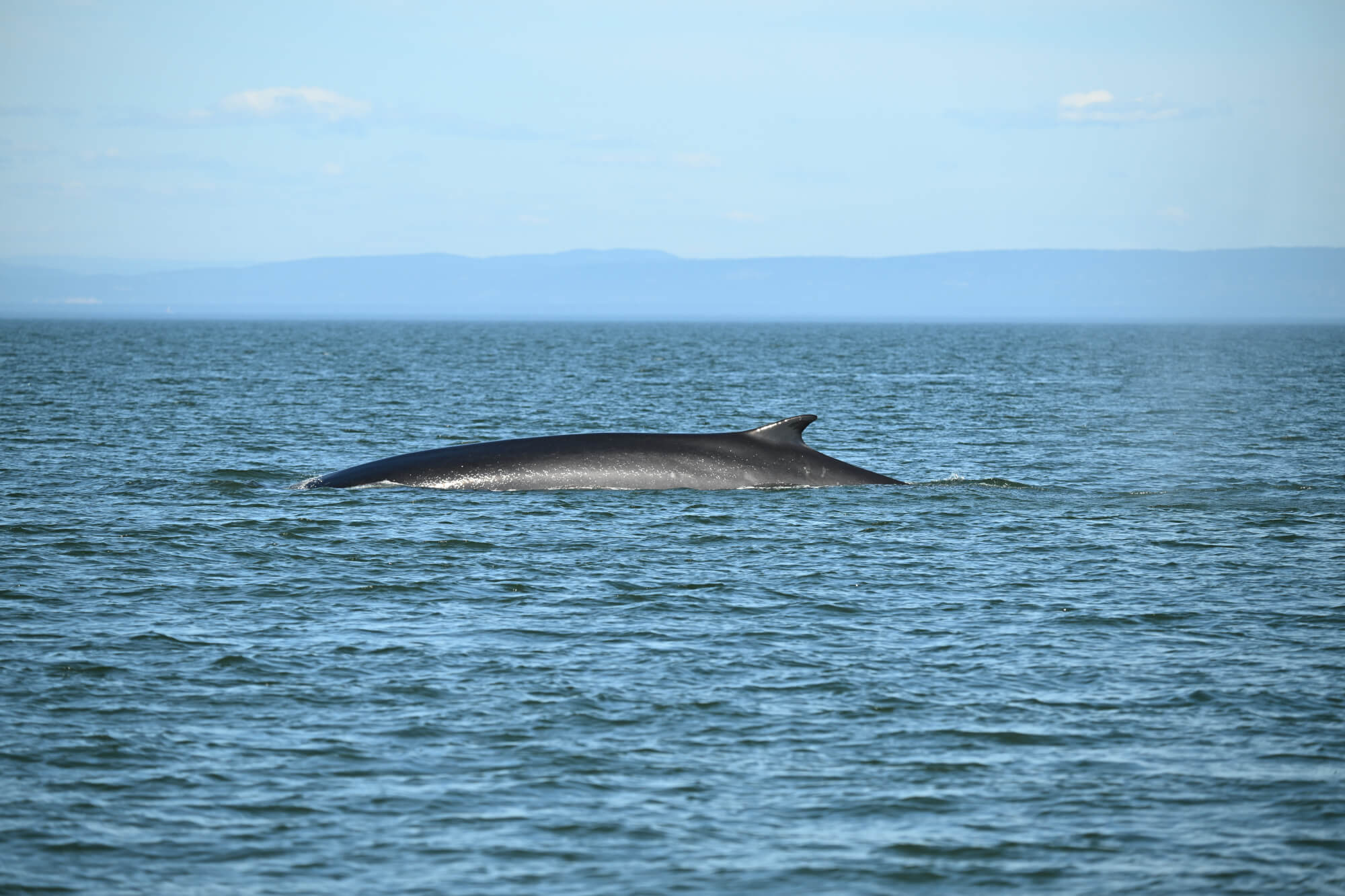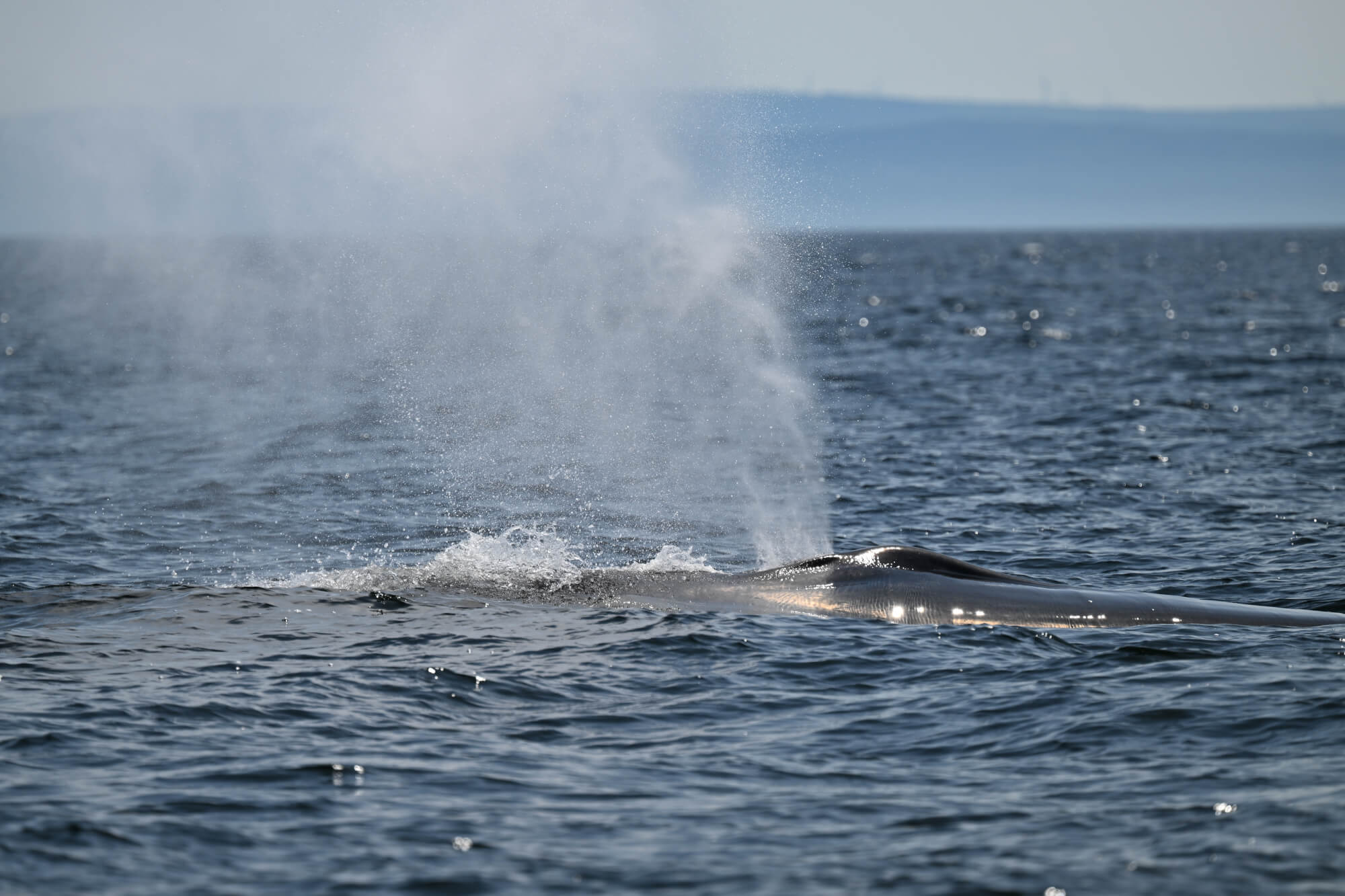The story of an unusual whale in our region is now making headlines. This article retraces the story of a northern bottlenose whale skeleton, from its recovery in the Gaspé Peninsula to its installation at Tadoussac’s Marine Mammal Interpretation Centre.
Recovery
In September 2021, two northern bottlenose whales were stranded in Listuguj in the Gaspé Peninsula. Initially pushed back into the water by police officers and local residents, they disappeared from sight for some time before stranding again at the same location, just a few hours later. A mobile team from the Quebec Marine Mammal Emergency Response Network (QMMERN) was then called in to assess the situation, as were the Marine Animal Response Society (MARS) and Fisheries and Oceans Canada (DFO).
The two individuals of this endangered species were found in a marshy area. Thanks to a local resident, specialists were able to approach by rowboat and confirm the death of one of the whales. As night fell, an intervention was planned for the following day. However, at dawn, the whale was no longer there, having likely freed itself with the rising tide. As for the carcass that remained on shore, a necropsy was performed to learn more about the individual. Shortly after, in the fall of 2021, the beaked whale was transported to the “5 Étoiles” farm in Sacré-Coeur to recover its skeleton.
According to the necropsy report, the most likely explanation for the presence of the two whales in the area was “naval sonar activities carried out in the waters off the southern coast of Nova Scotia from September 7 to 17.” The whales might have become frightened and ended up in the St. Lawrence, disoriented. However, no physical evidence from the necropsy could confirm this hypothesis.
Remember, if you happen to observe a stranded whale, do not attempt to take matters into your own hands. These are large wild animals whose behaviour can be unpredictable. The first thing to do is to contact Marine Mammal Emergencies at 1-877-722-5346.
Flensing and cleaning: A lengthy process
From 2021 to 2024, the aforementioned farm was the playground for several members of GREMM’s team as they prepared this beaked whale skeleton. The bones were first extracted from the carcass with the help of a few daring individuals and placed in plastic bins for the winter. During this period, tiny maggot larvae helped remove any lingering flesh from the bones. Yum!
The following summer was synonymous with cleaning! Rain or shine, the painstaking work continued. The bones were scraped and boiled to remove the last remaining traces of flesh and fat. Then, they were hosed down with a pressure washer, once again to help remove the most stubborn bits of flesh. This process was repeated several times in 2022 until the bones were completely clean.
In 2023 and 2024, the bones were soaked several times in a large water-filled vat to which a degreasing agent was added. The goal: to eliminate the slight greasy and oily residue secreted by the bones. Then, it was time to dry them! The bones of the beaked whale were placed on wooden pallets on the property of the “5 Étoiles” farm. In addition to thoroughly drying out the bones, UV rays also bleach them, making this an essential step before the whale skeleton can be displayed at the CIMM! The beaked whale finally completed its journey when it dried in a warehouse in the fall of 2024.
Assembly: A tricky puzzle
December 2024. Two naturalists are tasked with assembling the now fully dry skeleton. An enormous puzzle lies ahead!
The number one challenge is a lack of documentation and references. We don’t know what a real, complete beaked whale skeleton looks like. Strange as it might seem, there’s no such book entitled 6-Step Plan to Assemble a Northern Bottlenose Whale Skeleton. “It’s mainly because of the pectoral fins,” explains one of the naturalists, “because it was a young individual and we didn’t know which bone went which way, or even that the two pectoral fins had different bones!” Its young age translates into a lower bone density than that of an adult, the bones of which are fully formed. This juvenile’s ribs are sometimes connected to the sternum by cartilage rather than bone. This also means that the puzzle is slightly more complex because some of the pieces are missing.
Also noteworthy is the fact that the carcass does not truly reflect reality, as the animal is slumped and out of its natural environment. How is the scapula really positioned? How is the ribcage shaped? How many phalanges do the pectorals have? As one of the naturalists points out, “Nobody has ever taken an X-ray of a whale’s pectoral fin.”
The team also has to repair the damage that was caused when the whale was being recovered. The carcass was brought to shore using hooks, which damaged some of the bones. The badly banged up vertebrae and skull had to be repaired with epoxy.
Assembling the spine “is like stringing a pearl necklace,” explains one of the naturalists. Holes are drilled in the vertebrae to insert metal rods: a central rod and additional rods on the right or left, depending on the section. This method stabilizes the skeleton and prevents it from rotating. The scapulae are screwed to the body, and the pectorals are connected with small threaded rods and glue! Once the various sections are attached, the skeleton is placed on a homemade trestle (wooden support) to achieve the desired curvature.
And there it is: one skeleton ready for display! This amazing experience lasted less than three weeks.
Installation: high-precision work
Installation also comes with major obstacles. In early May 2025, our two assemblers tackled this daunting task. Erecting and dismantling scaffolding inside the showroom is already a difficult task, but the assembly crew also has to be careful with the other skeletons. Additionally, the new specimen will be placed in a difficult-to-reach location. The final drawback is that the skeleton will be installed in a submerged position at an angle of approximately 45 degrees. After three days and a lot of elbow grease, the skeleton will finally be ready to go on display!
Now you have a better idea of the scope of work required to put up a skeleton at the CIMM. This skeleton, and the animal it once belonged to, are a wonderful testament to the team effort demonstrated by GREMM’s staff, as it has enhanced the expertise and experience of several departments, from QMMERN to education, and of course, our master skeleton assemblers!
The activities mentioned in this article are governed by a permit issued under the Species at Risk Act (SARA). Under section 32(2) of SARA, it is strictly forbidden to possess or collect an individual, or part of an individual, belonging to a species designated as threatened or endangered, without first obtaining a permit from the Department of Fisheries and Oceans Canada.


